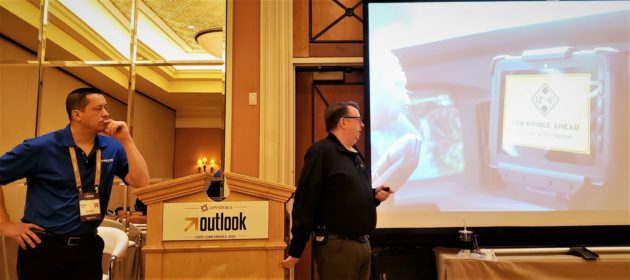The connected truck is here, and will continue to evolve
LAS VEGAS, Nev. – Drivewyze has some extra tricks up its sleeve, adding to the Canadian company’s flagship offering, PreClear weigh scale bypass.
Presenting during Omnitracs Outlook 2020 in Las Vegas, Nev., today, Brian Mofford, vice-president of government experience for Intelligent Imaging Systems, a Drivewyze subsidiary, said connected vehicles are here, and though his company is not an expert in the connected vehicle in traditional sense, they have expanded how they relay information to drivers in real time.
Hitting on the four pillars of the connected truck – safety, efficiency, reliability, and mobility – Drivewyze is now providing safety alerts to drivers with notifications regarding high rollover areas, low bridges ahead, and recommended use of low gear for steep grades.
Drivers see these alerts on the same device that runs PreClear, and is free to PreClear subscribers.
Steve Paul, senior product manager for Drivewyze, said more notification alerts are coming, and the overall goal is to help improve driver behavior.
Citing an incident in Colorado where an inexperienced driver burned out their brakes going down a hill and killed four motorists while running a stop light, Mofford said the state approached Drivewyze about geofencing steep grades to inform drivers when they are approaching. These alerts add to road signs and provides earlier notification to drivers.
Since then, 19 additional states have asked Drivewyze to do the same.
Safety alerts have been curated to ensure drivers are only seeing notifications at high risk area and not about every curve on the road.
On the efficiency front, PreClear helps the connected truck by reducing downtime and eliminating the need to use the braking system every time a driver comes to a weigh scale.
Real-time data and roadside infrastructure help deliver reliability to connected trucks. And for the final pillar of the connected truck – mobility – Drivewyze is working toward relaying dependable information to drivers about open parking stalls for when they are required to pull over to comply with HOS regulations.
“Truck parking is a huge problem,” said Wofford. “When a driver is running out of time, they need to park.”
Wofford said they are about a year-and-a-half away from releasing truck parking notifications, and he sees expansion in this area due to increased use of ELDs in the U.S. and Canada.
Other alerts in the works include dynamic notifications, such as work zones and emergency messaging.
Paul said improved infrastructure has helped technology companies expand the services they have long wanted to provide the trucking industry.
“We’ve been limited in the past,” he said, “but with the infrastructure in place now we’re prepared for the future.”

Also, in the future, Drivewyze is looking at ways to expedite inspections with e-Inspection. Wofford said around 75% of the information officers require to complete a Level 3 inspections comes directly off the truck’s license plate. Once that information can be transferred from the truck to the inspection facility, Wofford said Level 3 inspection times could be shortened from a 20-minute process to around 10.
“We really see expedited Level 3 as a precursor to future Level 8 inspections,” said Wofford.
Drivewyze is also looking into automatic payment of toll roads through its connected truck solution.
Robert Samuel, digital director of engine business for Cummins, also addressed during a session how his company is embracing the connected truck.
Cummins Connected Diagnostics provides engine information, recommended customer action, prioritized fault codes, suggested causes, performance impact, and links to repair locations to drivers to increase uptime and help simplify maintenance issues.
“I’m excited about this whole thing, it is clearly the future,” said Samuel.
Cummins also offers Connected Advisor, which interprets engine issues and minimizes reported issues by more than 65%, according to the company.
Navistar provides its Health Report technology to the connected truck, as well.
As Brian Mulshine, director of aftermarket technology for Navistar, explained, the Health report provides drivers and fleets with an overall summary of a truck’s health, highlighting any issues and when it is recommended they be addressed.
The solution even provides insight into synthetic fault codes, which are alerts that do not require a diagnostic, saving fleets time and money.
Navistar’s new International 360 solution is another option that brings everything into one central location, including insight into VIN-based parts catalogues showing where a part is located in real time.
Have your say
This is a moderated forum. Comments will no longer be published unless they are accompanied by a first and last name and a verifiable email address. (Today's Trucking will not publish or share the email address.) Profane language and content deemed to be libelous, racist, or threatening in nature will not be published under any circumstances.
Did you remove the line about improving driver behavior?